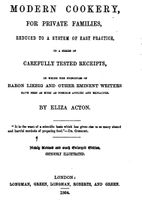Advertisement
To Choose Mutton
By Eliza Acton
Published 1845
The best mutton is small-boned, plump, finely-grained, and short-legged; the lean of a dark, rather than of a bright hue, and the fat white and clear: when this is yellow, the meat is rank, and of bad quality. Mutton is not considered by experienced judges to be in perfection until it is nearly or quite five years old; but to avoid the additional expense of feeding the animal so long, it is commonly brought into the market at three years old. The leg and the loin are the superior joints; and the preference would probably be given more frequently to the latter, but for the superabundance of its fat, which renders it a not very economical dish. The haunch consists of the leg and the part of the loin adjoining it; the saddle, of the two loins together, or of the undivided back of the sheep: these last are always roasted, and are served usually at good tables, or for company-dinners, instead of the smaller joints. The shoulder, dressed in the ordinary way, is not very highly esteemed, but when boned, rolled, and filled with forcemeat, it is of more presentable appearance, and to many tastes, far better eating; though some persons prefer it in its natural form, accompanied by stewed onions. It is occasionally boiled or stewed, and covered with rich onion sauce The flesh of that part of the neck which is commonly called the “best end,” or the back ribs, and which adjoins the loin, is the most succulent and tender portion of the sheep, and makes an excellent small roast, and is extremely good served as cutlets, after being divested of the superabundant fat. It is likewise very frequently boiled; but so cooked it makes but an unsightly and insipid dish, though an idea prevails in this country that it is a very wholesome one. Cutlets (or chops, as the butchers term them) are commonly taken from the loin, and are generally charged at a higher rate than joints of mutton, in consequence, probably, of the constant demand for them. They may likewise be cut from the saddle, but will then be very large, and of no better quality than when the two loins which form the saddle are divided in the usual way, though a certain degree of fashion has of late been accorded to them.* The scrag or that part of it which joins the head, is seldom used for any other purpose than making broth, and should be taken off before the joint is dressed. Cutlets from the thick end of the loin are commonly preferred to any others, but they are frequently taken likewise from the best end of the neck (sometimes called the buck-ribs) and from the middle of the leg. Mutton kidneys are dressed in various ways, and are excellent in many. The trotters and the head of a sheep may be converted into very good dishes, but they are scarcely worth the trouble which is required to render them palatable. The lion and the leg are occasionally cured and smoked like hams or bacon.

